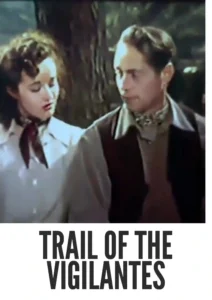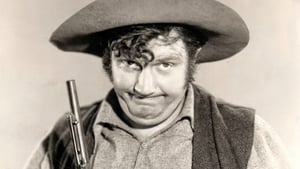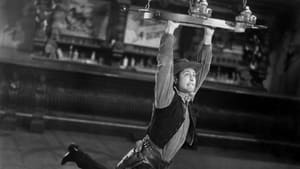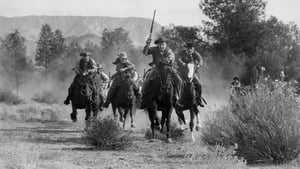Contact: info@alwanfilm.com
Video Sources 0 Views
Synopsis
Trail of the Vigilantes 1940 Colorized Review: A Comedy Western That Packs a Punch

Introduction
Released in 1940, Trail of the Vigilantes is an unconventional Western that blends comedy and action, directed by Allan Dwan. Known for his wide-ranging filmography, Dwan brought an unexpectedly lighthearted tone to this film, creating a unique take on the Western genre. The film stars Franchot Tone, Warren William, and Broderick Crawford, whose comedic timing and dynamic interactions add a new dimension to what might otherwise be a traditional Western.
As one of the early colored films, Trail of the Vigilantes stands out for its innovative approach, blending genres in a way that appeals to both Western enthusiasts and general audiences. This article will explore how the film’s colorized release impacts the viewer’s experience, examine its comedic influences, and place it in the larger context of cinematic history.
Check The Full Colorized Movies List
Check Our Colorized Movies Trailer Channel
Understanding Trail of the Vigilantes 1940 Colorized: Director, Cast, and Genre
Allan Dwan’s Vision
Allan Dwan was an experienced director, known for his versatile approach and commitment to exploring different genres. By the time he directed Trail of the Vigilantes, Dwan had honed his craft through decades in the industry, mastering silent films, comedies, action films, and more. In Trail of the Vigilantes, Dwan took on a new challenge by infusing the Western with elements of slapstick humor, setting it apart from the traditional, serious Westerns of the time.
Dwan’s vision was to showcase the Wild West with a comedic lens, bringing humor into scenes that would typically involve gritty, stoic action. His playful direction brings a sense of fun to the film, making it accessible to audiences who may not normally be drawn to Westerns. His work in Trail of the Vigilantes exemplifies his creative ambition, making it a memorable part of his diverse filmography.
The Cast’s Iconic Performances
Trail of the Vigilantes boasts a cast of talented actors, each of whom brings their own style to the screen. Franchot Tone plays the film’s lead, Tim Mason, a city detective who finds himself out of place in the Wild West. Tone’s portrayal of the “fish-out-of-water” character adds a layer of comedy to the film, as he brings a city-slicker’s sensibility to a world of cowboys and outlaws.
Supporting Tone is Warren William as the villainous rancher, alongside Broderick Crawford, who delivers a memorable comedic performance. Their interactions with Tone create an entertaining dynamic, blending tension with moments of levity. The cast’s chemistry and comedic timing contribute to the film’s lasting appeal, making Trail of the Vigilantes a standout in both their careers and the genre as a whole.
Genre Fusion: Western Comedy
Trail of the Vigilantes is a rare example of a Western comedy, a genre fusion that was relatively uncommon in the 1940s. Western films of the era typically focused on serious themes of justice, revenge, and survival in the untamed frontier. By introducing humor into this formula, Trail of the Vigilantes offers a refreshing take on the Western. The film’s comedic approach allowed it to reach a broader audience, as it brought a lighter tone to a genre often characterized by somber themes.
Exploring the World of Trail of the Vigilantes 1940 Colorized: Plot and Characters
Plot Summary
The film follows Tim Mason, a detective from the city who is sent to investigate a series of murders in a small Western town. As Mason delves into the case, he finds himself at odds with the local ranchers, who are unaccustomed to his city ways and modern detective methods. His attempts to uncover the truth are met with resistance, and he quickly realizes that the locals have their own way of handling justice.
Despite the danger he faces, Mason’s outsider perspective brings both humor and fresh ideas to the community. He eventually partners with a group of vigilantes, each with their own distinct personalities, as they set out to uncover the mystery and bring peace to the town. The film’s plot is filled with twists, humor, and action, combining traditional Western elements with a comedic twist that keeps the audience engaged.
The Memorable Characters
Each character in Trail of the Vigilantes adds to the film’s unique tone. Tim Mason’s transition from a serious detective to a reluctant cowboy creates numerous comedic moments, while Broderick Crawford’s performance as the rough-and-ready cowboy injects lighthearted humor. The vigilantes themselves are a colorful bunch, each with their quirks and idiosyncrasies, adding depth and charm to the film’s ensemble cast.
The Art of Film Colorization
How Colorization Works
Colorization is the process of adding color to black-and-white films, often involving careful selection of hues to match the natural tones of the setting and costumes. This process has evolved over the years, moving from hand-tinting individual frames to digital colorization. The colorized version of Trail of the Vigilantes uses vibrant hues to bring the dusty plains and rugged ranches of the Wild West to life, enhancing the film’s visual impact and highlighting the detailed set designs and costumes.
Development Over the Decades
Early colorization techniques were met with mixed reviews, as viewers debated whether color added to or detracted from the original film experience. In the years since, colorization technology has improved, allowing for greater accuracy and artistic control. Today, colorization is often used to introduce classic films to new audiences, providing a bridge between historical cinema and modern preferences.
Early Colored Films: A Brief History
Pioneering Color Techniques
The journey toward full-color films began with hand-tinting and selective coloring, where individual frames or scenes were painted to create a limited color effect. Technicolor, which emerged in the 1930s, revolutionized color cinema by allowing filmmakers to capture a full spectrum of colors. This breakthrough opened up new creative possibilities, making films like Trail of the Vigilantes more visually engaging when revisited in color.
Technicolor films were initially seen as novelties, but they quickly became popular with audiences and filmmakers alike. The development of colorization techniques continued to evolve, ultimately allowing for the restoration and enhancement of black-and-white classics.
Trail of the Vigilantes 1940 and Its Early Colored Version
Why Release in Color?
The decision to colorize Trail of the Vigilantes was motivated by a desire to enhance the film’s appeal for contemporary audiences. By adding color, the filmmakers aimed to draw attention to the film’s comedic and action elements, making it more accessible to a new generation. The colorization also allows for a richer visual experience, emphasizing the film’s Western landscapes, costumes, and set pieces.
Impact on Storytelling and Visual Appeal
The colorized version of Trail of the Vigilantes brings out the richness of the Western setting, from the desert landscapes to the costumes worn by cowboys and outlaws. This added layer of visual detail enhances the viewing experience, making the action sequences more dynamic and the characters more relatable. While some purists may prefer the original black-and-white aesthetic, the colorized version offers a fresh perspective on the film’s artistic elements.
The Debate Over Film Colorization
The Ongoing Controversy
Film colorization has sparked debate among cinephiles, historians, and directors. Some argue that colorization alters the filmmaker’s original intent, as many directors crafted their films specifically for black-and-white cinematography. This perspective sees colorization as a compromise of the film’s artistic vision, diluting the impact of carefully crafted lighting and shadow.
On the other hand, proponents of colorization believe it can revitalize classic films, making them more appealing to younger audiences. By updating the visuals, colorization can attract new viewers and broaden the reach of historical films.
Examining Trail of the Vigilantes as an Early Colored Film
Does Color Add or Distract?
The colorized version of Trail of the Vigilantes allows for a new appreciation of its visual elements, particularly its comedic and action scenes. The vibrant colors highlight the costumes and bring out the details of the Western landscape, giving the film a fresh look. However, for some viewers, the colorization may detract from the film’s original tone and style, making it feel less authentic to the period.
Ultimately, the effect of colorization is subjective, depending on the viewer’s preferences. For those who enjoy a more traditional Western experience, the black-and-white version offers a classic feel, while the colorized version provides a unique, updated viewing experience.
Influence and Legacy: Trail of the Vigilantes 1940 Colorized’ Impact on Cinema
Setting the Stage for Genre Fusion
Trail of the Vigilantes helped pave the way for future genre-blending films, showing that Westerns could successfully incorporate comedy. The film’s success demonstrated the viability of genre fusion, influencing other Western comedies and encouraging filmmakers to experiment with new combinations. Its impact can be seen in later Western comedies, such as Blazing Saddles and City Slickers, which continued the tradition of adding humor to the Western formula.
Director’s Cinematic Legacy: Beyond Trail of the Vigilantes 1940 Colorized
Allan Dwan’s Lasting Influence
Allan Dwan’s career spanned nearly five decades, during which he directed over 400 films across multiple genres. His willingness to experiment with different styles and themes has left a lasting legacy, influencing directors who followed. Dwan’s work in Trail of the Vigilantes exemplifies his versatility, showing that he could balance humor and action within the Western genre. His contributions to early cinema continue to be celebrated, making him a respected figure in film history.
Themes Explored in Trail of the Vigilantes 1940 Colorized
Justice, Loyalty, and the Absurd
Trail of the Vigilantes touches on themes of justice and loyalty, while also exploring the absurdity of certain Western conventions. The film’s humor offers a lighthearted critique of the Western genre, poking fun at its stereotypes while still embracing its core elements.
Reception and Controversy Surrounding Trail of the Vigilantes 1940 Colorized
Audience Reactions and Critical Reception
At its release, Trail of the Vigilantes was well-received for its humor and originality. Critics appreciated Dwan’s daring approach and the cast’s comedic performances, while audiences enjoyed the film’s entertaining storyline and unexpected moments of humor. However, as with many colorized versions, the film faced criticism from purists who preferred the black-and-white original.
Where to Watch Trail of the Vigilantes 1940 Colorized Online
Today, Trail of the Vigilantes is available on various streaming platforms, such as Amazon Prime Video and Turner Classic Movies, where audiences can choose between the original black-and-white version and the colorized edition.
FAQs About Trail of the Vigilantes
Q: What makes Trail of the Vigilantes unique? A: Its blend of comedy and Western action makes it a distinctive entry in both genres.
Q: Who directed the film? A: Allan Dwan, known for his genre versatility and cinematic innovation.
Conclusion
Trail of the Vigilantes (1940) remains a unique and influential film, blending humor with classic Western action. Allan Dwan’s direction and the cast’s comedic talents make it a memorable viewing experience. Whether enjoyed in black-and-white or in its colorized version, this film continues to captivate audiences, showcasing the timeless appeal of genre-bending cinema.














